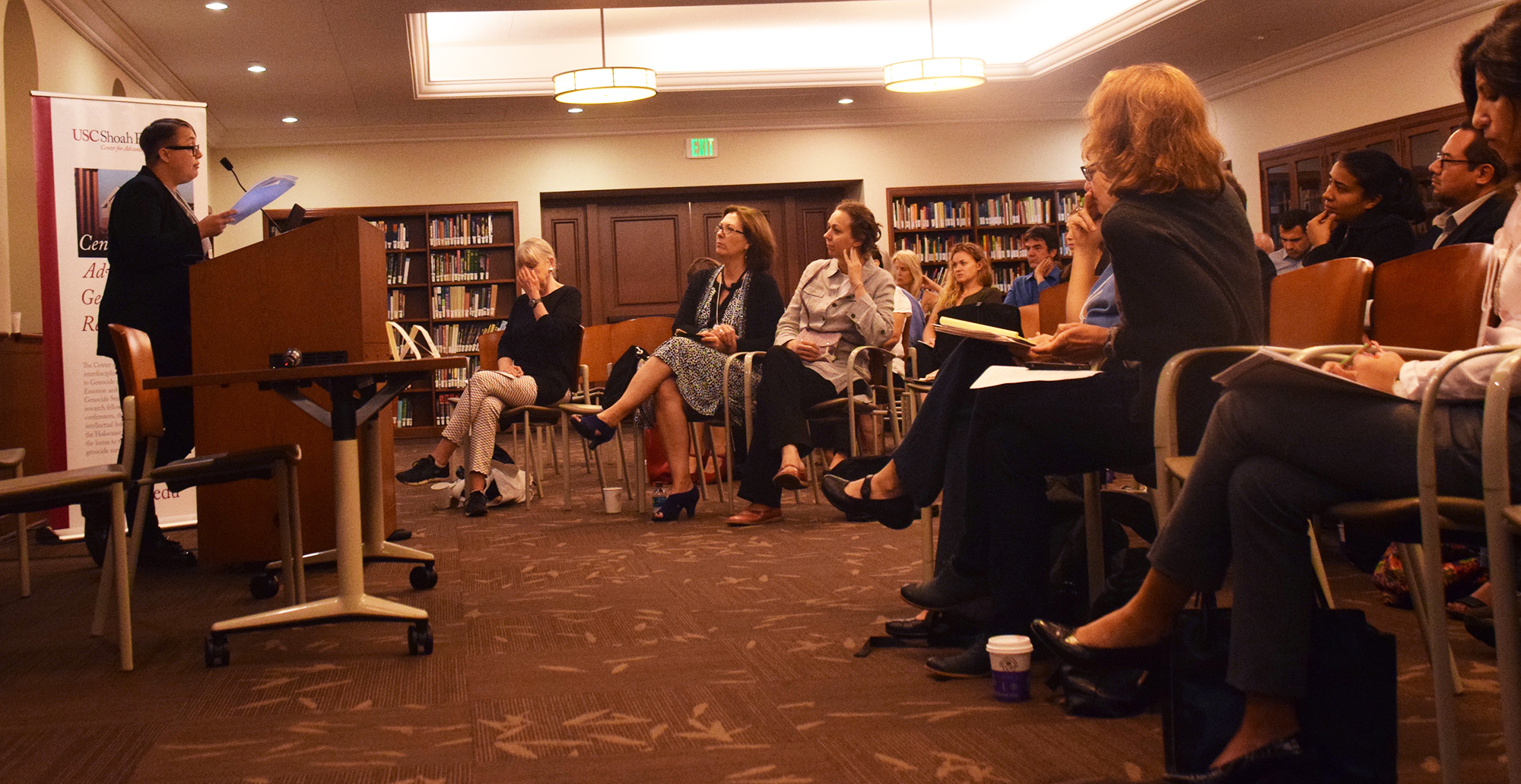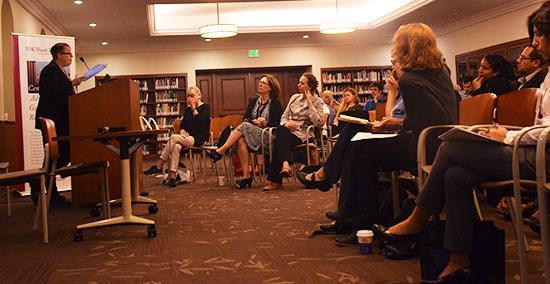Guatemalan Genocide Conference Panels Cover Justice, Solidarity and Personal Stories


Susan Fitzpatrick-Behrens chairs the "Transnational Impacts of Genocide" panel
Over the course of the USC Shoah Foundation Center for Advanced Genocide Research’s three-day conference “A Conflict? Genocide and Resistance in Guatemala,” over a dozen scholars from all over the world gave presentations about their research on various aspects of the Guatemalan Genocide. Here is a sample of just a few of those presentations.
Brigittine French, a professor of anthropology at Grinnell College in Iowa
Much as Hitler relied on anti-Jewish propaganda to rally ordinary Germans, Efraín Ríos Montt – president of Guatemala from 1982 to 1983 – employed a rhetorical strategy to shore up citizen support for the military’s scorched earth policy against Guatemala’s indigenous people.
Specifically, Ríos Montt used the metaphor of Guatemala as a family, of which he, as president, was the father and the citizens were the children.
This was the primary argument of Brigittine French, a professor of anthropology at Grinnell College in Iowa, in her talk Monday (Sept. 12) during the panel entitled “Racist Discourse and Genocide.”
Under a patriarchal pretext, French argued, Ríos Montt justified violence against perceived agitators as a disciplinary measure to keep the family together during a time of national crisis.
“Within this logic, it gets tied to a deeply broader, resonant evangelical Christian moral discourse, where change must come from within,” she said. “And so there’s really no need to change anything except one’s own internal state. And then of course (for citizens) to comply with the patriarchal rules of the family.”
In an Orwellian twist, Ríos Montt – who declared himself the “presidente de la familia” – used this patriarchal conceit to cast blame on the parents of people who were forcibly disappeared or murdered by the state.
“He identifies the immoral family as the source of all subversion,” she said. “In this manner, they are presumed to be responsible for the death of their children instead of agents of the state or anyone else.”
Catherine Nolan-Ferrell, a history professor at the University of Texas-San Antonio
The northward flow of indigenous Guatemalans into Mexico to escape extermination at the hands of their own government in the late 1970s and early 1980s initially provoked a xenophobic response – sometimes with tragic results.
The fraught relationship between Mexico and fleeing Guatemalans was the subject of a presentation Tuesday (Sept. 13) by Catherine Nolan-Ferrell, a history professor at the University of Texas-San Antonio.
Among the first to express alarm were Mexican labor leaders, who charged that the Guatemalan refugees were cutting wages and taking jobs, said Nolan-Ferrell, whose talk was titled “The Guatemalan Refugee Crisis in Southern Chiapas, 1980-1984.”
“There’s one interview where (somebody says), ‘They are taking bread out of the mouths of Mexican children,’” Nolan-Ferrell said.
She went on to tell the story of 400-plus refugees who arrived by boat. The Mexican government deported all but about 45.
“We think they were all killed,” she said of the deportees.
However, Nolan-Ferrell argued, pressure exerted by the survivors, as well as ordinary Mexican citizens – and the church -- influenced the Mexican government to start thinking of the mass migration as a group of political refugees, as opposed to people in search of jobs.
Citing an example of citizen concern, she quoted a letter written to a church official from the member of a Mexican farming family.
“We have a real problem, and we want to help these people, but we don’t have the resources to do so.”
Even though Mexican law at the time lacked a mechanism for handling refugees, the government in late 1981 began setting up refugee camps.
She cited another letter written by refugees to the governor of Chiapas, Mexico requesting official refugee status because they intended to return to Guatemala once the fighting subsided.
“You can see where the resistance is here,” she said. “How do we label the people who were fleeing from the violence? They are very actively trying to push their position as refugiados, not because they per se want to settle in Mexico, but because they want to eventually be able to go back to Guatemala.”
Susanne Jonas, a Latin American and Latino Studies professor at UC-Santa Cruz
It was commencement day 1991 at Harvard University, and a man in robes named Hector Gramajo was standing in line, waiting to accept his master’s degree, when he was served with a subpoena.
Gramajo, as it turns out, was a Guatemalan war criminal, but certain powers that be in Washington D.C. felt he might make a good Guatemalan president, and had arranged for him to obtain a degree at the Ivy League school.
But now he was getting his comeuppance. This wasn’t the product of a move by the American government or NGO, but rather a group of eight Guatemalan refugees who had fled the violence, and now were filing a civil suit against him for atrocities committed against their relatives.
This anecdote anchored the talk given by Susanne Jonas, a Latin American and Latino Studies professor at UC-Santa Cruz. Her key point: that Guatemalan refugees and migrants in the United States have been the primary drivers of bringing perpetrators to justice.
“The influence of Guatemalan refugee organizations in the United States helped put the Guatemalan government more sharply under the glare of world opinion,” she said. “They influenced U.S. public opinion to the point that Congress and eventually Presidents were no longer able to fully support the Guatemalan regimes."
She added that this includes then-President Ronald Reagan, who was a "cheerleader" for then-Guatemalan President Efrain Rios Montt, who in 2013 was convicted of genocide for the killings on his watch, although his conviction was overturned on a technicality. He will be retried.
In the 1980s, Reagan was barred by Congressional legislation from sending the Guatemalan military direct military assistance, Jonas said.
The indigenous community has also played a key role in a successful suit against the U.S. government in the early 2000s granting asylum to some 250,000 Guatemalans and Salvadorans, as well as in the recent war crimes trials against Rios Montt.
As for Gramajo, he never paid a penny of the $47.5 million judgment against him, but he was barred from the United States. He ran for president in Guatemala, but was trounced, picking up just 1 percent of the vote. He died in 2004.
Morna Macleod, a researcher and lecturer at the State Autonomous University of Morelos in Mexico
Morna Macleod, a researcher and lecturer at the State Autonomous University of Morelos in Mexico -- and a former human rights worker who worked in Guatemala during the finals years of the genocide -- gave a presentation about reports written 30 years ago by the United Nations and NGOs whose work addressed the mass violence in Guatemala as it was unfolding.
“Thirty years down the track gives you a very different reading,” she said. “I wanted to see how genocide was framed.”
Before getting into the reports, Macleod – whose talk was titled “International Solidarity and Genocide in Guatemala in the Eighties” -- shared the story of a testimonial taken of an indigenous woman whose words haunt Macleod to this day.
"Why did they kill us like dogs?’" the indigenous woman said, continuing "I think these massacres are worse for women, because first the women are raped, and after raping her, they pull out her tongue they pull out her eyes, they tear away her breasts and afterwards they just leave her dying there. Many times we have said witnessing such terrible suffering that we would prefer it if they simply shot us.”
Meanwhile, the official reports were tame – even whitewashed – in comparison.
A few highlights:
• A United Nations report authored by human rights investigator Mark Colville – a British judge and politician – denied the scorched earth tactics, made no mention of massacres, and recommended that the international community “look with benevolence on the newest set of progressive initiatives (of the military).”
• A 1981 report by Amnesty International is carefully worded. It mentions 21 “Indian peasants” who died in the Spanish embassy. But there is no mention of massacres, nor of the fact that the victims are of Mayan descent.
• A 1983 report by Trocaire, an Irish aid agency, whose delegation was headed by a bishop, was actually pretty detailed. It did not shy away from mentioning indigenous people. It explicitly mentioned genocide, massacre and scorched earth. But there was little mention of women. A quote from the report: “The victims have included many thousands of ordinary peasants and workers, the majority of them of Indian communities, political and trade union leaders, academics, university students, priests, nuns, development workers and thousands of catechists.”
Like this article? Get our e-newsletter.
Be the first to learn about new articles and personal stories like the one you've just read.